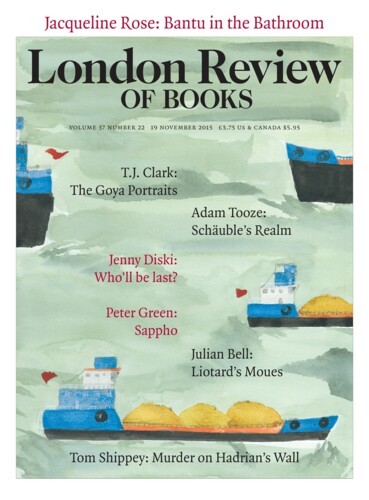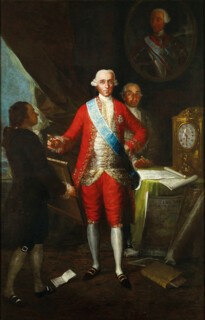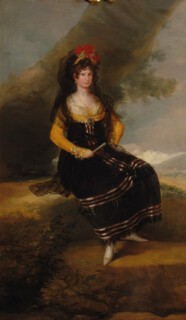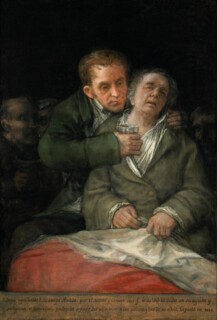Along the façade of the National Gallery these days are hoardings announcing Credit Suisse’s patronage of the Goya show, with the invitation: ‘Now you can bring Goya’s portraits to life, using your smartphone.’ I didn’t think much of the invitation as I passed it – seeing it over the head of a pixie levitating in Trafalgar Square seemed appropriate – and I was pretty confident I’d be able to bring Goya’s portraits to life without the help of an iPhone. But when a few minutes later I stood in front of The Count of Floridablanca I was suddenly less sure. I couldn’t tell – the question came on me unbidden and immediately, before I had a clue what provoked it – whether the painting wanted or expected me to bring the count to life, for all its determination to launch him in my direction. I could see that the picture was working a familiar ‘bringing to life’ machinery – working it full throttle. I was suitably impressed by the main figure’s stare (and blue sash). It wasn’t long before I picked up the painting’s heavy acknowledgments of Las Meninas, and realised that at some level the second stare outwards, over the count’s shoulder, coming from a member of staff, was meant to make the main character’s authority over me – the count’s recognition of his own ‘lifelikeness’ (it has been suggested that he is looking at his reflection in a mirror) – doubly irresistible. But is it? Did Goya intend it to be?
The longer I looked at the painting the more I was drawn to the dialogue taking place, sotto voce, between the over-coloured count and his shadowy double hung high on the wall above him – a faintly preposterous rehash of the mirror in Las Meninas, where king and queen make their necessary appearance. The dialogue in Goya – the shadow play, the hovering between repetition and caricature – seemed to me to drain both parties (I presumed that the figure on the wall was an ancestor, or maybe the monarch himself) of reality. The second man staring at me – again, a version of a great moment in Las Meninas, where Velázquez in the background fixes his royal sitters with a predatory gaze – seemed to peer from the picture with an expression compounded of alarm, disbelief and sheer uncomfortable consciousness of his place in a game of looking. Looking and being looked at and thereby ‘brought to life’. He’d be damned if he’d occupy the place he’d been allotted. I found myself staring back at the painting in much the same frame of mind. The more I responded to Floridablanca’s local (stunning) reality effects – the silver shimmer on the count’s sash, the light through the glass on the clock face, the spectacles clutched in his fingers, the Zurbarán notebook glowing on the floor – the more it seemed to me they didn’t matter. What mattered – what made the painting Goya’s – was the pervasive unreality of the set-up, swallowing the world of objects and persons no sooner than it conjured them up.
I realise that I haven’t put my finger on what produced the feeling of unreality, and I’m not sure I can. I know there are dangers in trusting the feeling at all. Anyone looking at Goya’s portraits can’t avoid seeing them against the background of the Caprichos and Black Paintings and the unbearable private albums, some drawn, some etched and aquatinted, dwelling on torment and degeneracy. Perhaps I am reading in – reading back – too much of the later Goya into Floridablanca, which may just be a young professional’s slightly over-reaching bid for fame. Scholars for the most part advise people like me to avoid ‘seeing X in the light of Y’ too readily where Goya is concerned (Xavier Bray’s meticulous catalogue is typical): they are happy with the idea of a two-track or three-track Goya, court painter and church decorator at the same time as provider of strangeness and horror to a small circle of ilustrados. Poking about in the world of the portraits on the lookout for signs of alienation or revulsion strikes the experts as misguided. Goya, they tell us, was a brilliant servant of those in power: his problem was that there were too many claimants, constantly at one another’s throats. He ended as a liberal in exile – like many another pragmatist in an age of doctrinaires. But this doesn’t mean he was a covert critic, persistently or even episodically, of the classes and kinds of job he made his living from: Théophile Gautier’s later guess at Goya’s feelings in his portrait of Charles IV and Family – ‘the baker on the corner and his wife after they’ve won the lottery’ – is unforgettable and wrong.
Yet I stand by my first intuition. Of course as I spent more time at the show and became accustomed to Goya’s visual idiom (‘accustomed’ with Goya is always a relative term) some of the strangeness began to wear off. I thought I could see occasions when the artist was able and willing to perform fully in public mode, putting his ‘brilliance’ at a patron’s disposal. (Though even here it was easy to lose confidence. The hideous pyrotechnics applied to the finery of the hideous Ferdinand VII in Court Dress brought on a touch of the Gautier again, hard as I tried to suppress it.) Equally, I came to recognise those portraits of friends and allies – more and more of them towards the end, clustered in exile from Ferdinand’s counter-revolution – where simple knowledge and sympathy won out. The portraits of Fernández Moratín and José Duaso y Latre and Juan Batista Muguiro, the last one painted when Goya was 81, are triumphs of descriptive patience. Moratín is set down with all the solidity and tenderness of a Courbet. Paintings like these give the lie to the idea that ‘unreality’ in Goya, where it exists, is rooted in an essentially personal, irremediable pathology.
It is rooted in the times – rooted in a moment when the bonds of mutuality that normally support the making of likenesses were in doubt. Those bonds, when one cares to look at them, or when for some reason they come to the surface for an artist, are especially strange and elaborate in the case of portraiture, and fragile. Twenty years ago, in the high times of deconstruction, the literary critic Harry Berger coined the phrase ‘fictions of the pose’ for the circuit of wishes and assumptions he believed made portraiture (and its viewing) possible. Art history, for reasons not mysterious, has set Berger’s scepticism aside. But the Goya show brings the ghost back into the room. ‘A portrait,’ Berger says, ‘presupposes a desire and decision to be portrayed.’ So naturally we’re inclined to read it as signifying the activity of portrayal itself, understood from the start as involving two parties. But not only this (here’s where the contract becomes more elaborate): we’re invited to believe ‘that the portrait not only signifies but also represents its cause. It is an image of the act of portrayal that produced it.’ This is beautiful, Berger says, but fictional – a tissue of fictions:
The image constitutes what it pretends only to reflect … Its claim is that the sitter and painter were present to each other during the act of painting; that the painter is not only the delineator of the pose but the sitter’s first observer; that the sitter did in the studio (or whatever) what she or he appears to be doing in the portrait; and that in posing before the painter he or she was projecting the self-representation [he or she wanted to aim] at future observers.
This is how a sitter staged herself (says a portrait, according to Berger), and then how she responded, easily or uneasily, to the sight of what the painter had begun to do with the staging. And this is how the painter responded to her complicity or resistance. And so on. Or so we want to believe.
Many things do and don’t follow from Berger’s account. We’re dealing with a critic not an iconoclast: Berger never wished or expected his acts of scepticism to budge the fictions much. They are tenacious because at one level they go with the neural and behavioural entanglements that make any kind of mutuality possible, in art or life. The fiction of the pose is as indelible as the fiction of the ‘I’. Nonetheless, art can have doubts, just as literature can, about the mechanics of subjectivity. Portraiture in particular can operate happily in two frames of mind: it can be monstrously confident about the alchemy of paint as ‘presence’ and ‘character’, and yet flaunt its knowledge of the weirdness – the deep obscurity – of the conversions in play. (Frank Auerbach as portraitist would be an example.)
Where does Goya stand in this? Obviously I’m going to argue (I have already) that in front of his finest portraits the tightrope of claims just outlined tends to unravel. An unreality creeps up on us, or sometimes – I think of The Countess of Fernán Núñez, or even The Duchess of Alba – it stares us down and stamps its pretty feet. But again, what do I take the word ‘unreal’ to apply to? Unreality, given what Berger tells us (and our background reverence for Barthes’s ‘reality effect’), must be an effect – it must be a fiction, a production, with a material and ideological base. And clearly I want to value the unreality when I encounter it – I want to see it as a form of truth-telling (in particular circumstances) and an aesthetic triumph.
Take The Countess of Fernán Núñez. I shall not try the reader’s patience by spelling out the obvious: that never has a painting worked so hard to de-realise the setting and stance of its sitter (all three words here double back on themselves as we look at Núñez, and the association of the first with jewellery and gilt frames seems fitting), and yet never has the resultant dream world appeared so much the condition of a terrible intimacy. (My final phrase is overheated, I grant, but I can’t come up with anything cooler that strikes me as doing justice to the countess’s trapped coquettishness.) Of course the setting is a fable. The great tree trunk glowering and growling over the ground at left like a gathering storm; the cottonwool glacier of cloud to the right; the pointing toe on the edge of the precipice; the Jezebel halo of red and black against the tree; the level after level of rock and scorched grass going down to darkness; and the stiff cantilevered arms: everything here is absurd and momentary and touching, a tableau, a stage set, a false confession. And the falsity is its truth. It is what convinces the viewer (and doubtless this too is an effect) that the picture was born from deep collusion, from a true mutual acknowledgment of distance – immense, unbridgeable, guarded by rampart after rampart – but also sympathy. I take it that after a while we come to notice the square miniature on the countess’s breast, and assume that it is of her husband. His pendant portrait, insufferably cool, is directly across the room in the National Gallery’s show. Xavier Bray tells us that the count loved another woman (whom he took to London instead of his wife when he was made ambassador) and that the countess answered in kind. But we’d guess as much from what Goya has given us.
Colour and light in the portraits – The Countess of Fernán Núñez is a prime example, but so are The Duke and Duchess of Osuna and Their Children and the great green portrait of Gaspar Melchor de Jovellanos – flicker bafflingly between vividness (lifelikeness) and make-believe. Goya is a master of greys: sometimes one feels that a grey tinged with pink, as in Jovellanos, or with mortuary green, as in Self-Portrait with Doctor Arrieta – the colour’s innate ghastliness brought back just far enough into the world by the touch of its complementary – speaks directly to his whole sense of life. ‘Damaged’, ‘precarious’, dreamlike, bewildered, and above all profoundly (unknowingly) terrified: this is the world as Goya conceives it.
We know, again from the experts, that Jovellanos, when Goya painted his portrait, had just been appointed the king’s ‘minister of grace and justice’. This was as much of a liberal, Enlightenment moment – a few months in late 1797 and early 1798 – as Spain ever had. Jovellanos came from Asturias: he was a linguist and economist, disciple of Adam Smith, mild enemy of the Inquisition and fierce proponent of enclosures (in a backward country too full of commons). He was humane. He let the ailing Goya keep his coat on at dinner, and learned a bit of sign language so the two of them could talk – Goya was already profoundly deaf. He got the painter a commission for frescos in San Antonio de la Florida – wonders of the world, they turned out. Jovellanos’s picture was painted most probably in March 1798. By August the minister was back on his Asturian estates in disgrace. But again, wouldn’t we know the tentativeness of Enlightenment in Spain – the grey-green improbability of Jovellanos’s dream – from the picture itself, without any inkling of its ‘background’? Minerva on the minister’s desktop is a wraith, waiting for the owl to take flight.
The last room of the exhibition gathers together portraits of friends and exiles done in Bordeaux, and puts at the centre the masterpiece Goya painted in 1820, Self-Portrait with Doctor Arrieta. It is the show’s most daunting moment. Arrieta was in a sense a second Jovellanos for Goya: intimidatingly clever, compassionate, authoritative, no doubt a touch frightening in the way great doctors are. Only this time Goya owed him his life.
It is indicative, I think, that when Goya set himself the task of describing the boundary (or lack of one) between living and dying, as he did here, he seems automatically to have thought in terms not just of a double portrait – which would be extraordinary enough – but of a group portrait, or the parody of a group portrait, or a portrait of ‘life’ (just) surrounded and haunted by entities from elsewhere. That is to say, Arrieta presents us with Goya’s deepest thinking about himself and other people, and their reality and unreality for him. Any attempt to put that thinking into words is bound to be crude and intrusive, rather like Arrieta’s fist as he holds the glass (of hemlock? of blood?), trying to persuade Goya to swallow, when what one wants is a prose as unnoticeable and supportive as Arrieta’s other hand on Goya’s shoulder. But here goes.
Could we say that Arrieta in the picture stands for life and Goya for death – for the deathwish that is life’s constant salving attendant, the wish and need to escape from a ‘reality’ that is too often disorienting and cruel? Maybe. So much is done in the picture by the difference in size between the heads of the two men in the foreground – much greater than one realises at first glance – and the difference in colour. What an effort it must be to be – to remain – as vital as Arrieta! Don’t we all envy Goya’s half-sentient greyness? Or consider the two men’s poses (forgetting Berger’s phenomenology for a moment, and concentrating on – empathising with – actual bodily positions). If we saw Arrieta’s pose and expression abstracted from their present matrix, wouldn’t we guess he was a lover, or a philosopher listening to the argument of a young disciple? (He’ll come up, we’re sure, with a kind but devastating counter-example.) Can we disentangle the doctor from the gallery of tonsured intruders behind him – I hear them slobbering and snuffling in the shadows? Isn’t he the carrier, in spite of himself, of their ghoulish enthusiasm for the ‘good death’? What is Goya looking at? How does he (how do we) experience his body? Is he supporting himself, or leaning weightlessly on Arrieta’s chest? The slight twist of his body under the grey coat and white collar is weariness itself. But Goya’s hands – or one of his hands – can still summon up enough ‘hold on life’ to pucker the folds of the sheet between finger ends. How intently the vile attendant in the dark next door strains to see the pressure, not wanting to miss the moment when it stops! How alive and in pain the flayed pink of the underblanket, and the traces of it showing through the sheet!
Historians who ask us not to look at Goya’s portraits with his albums and Black Paintings in mind lose me completely when it comes to Self-Portrait with Doctor Arrieta. I can’t see what more Goya could have done to spell out, in this summa of his art, that for him – for his whole tortured culture – the sleep of reason was everywhere, invading all genres, informing the matter of being ‘oneself’. I read back from the dying Goya to the half-smiling Jovellanos anticipating defeat. Arrieta’s insistence on life in the Self-Portrait helps me with Floridablanca’s (though of course the count’s is sinister in ways the doctor’s is not). Even the tension of the Countess of Fernán Núñez’s pose – her holding of it against the odds, on the lip of the precipice, against the encroachment of darkness – comes to make more sense. It is, for me, a premonition of the old painter’s glance back to us from the edge of the grave. Terrible projection and anachronism, all this. But such is Goya.
Send Letters To:
The Editor
London Review of Books,
28 Little Russell Street
London, WC1A 2HN
letters@lrb.co.uk
Please include name, address, and a telephone number.





